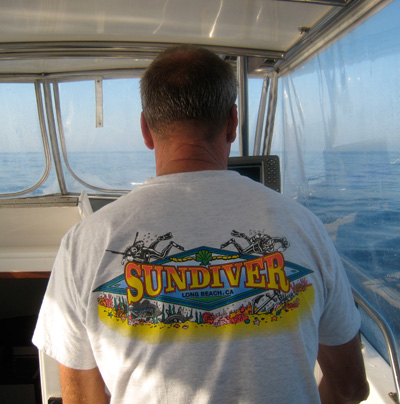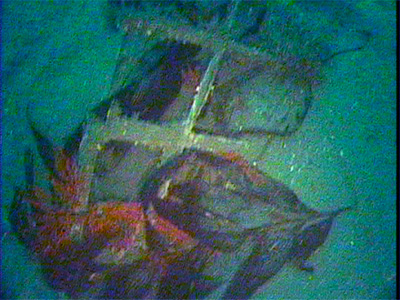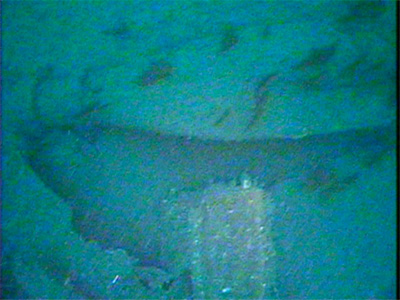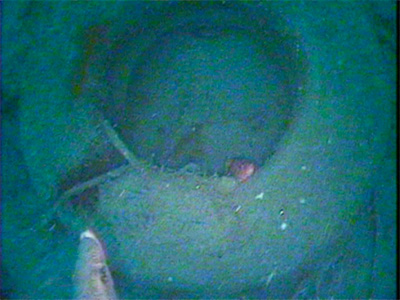
Side scan sonar image of the B-36 crash site off Mission
Beach, California.
B-36
Discovery
October 2008
Capt. Ray Arntz, John Walker, and myself left Long Beach
aboard the SUNDIVER II
for the
80 mile trip south to the waters off MIssion Beach,
California. We knew our mission to find the elusive B-36
wouldn't be an easy one. Multibeam bathymetric images of
the seafloor in the area showed a very rugged bottom
composition with numerous natural reefs that would surely
complicate the sonar search. The 474 page accident report
only revealed subtle clues as to the whereabouts of the
plane. Based on the accident report and the bathymetric
imagery, we calculated several areas that we believed would
lead us to the final resting place of the lost B-36 bomber.
The side scan sonar would have to do the rest.

Multibeam Bathymetry off San Diego, California
U.S. Geological Survey

We arrived in the area in the early afternoon on Day 1 and
deployed the side scan sonar.

You can see the towfish cable trailing from the A-frame off
the stern of SUNDIVER II. We spent the next several hours
scanning the area. Sooner than expected we found what
looked like a massive debris field on the bottom. We
scanned the target from several different directions to
confirm it's size and location.

We prepared the underwater drop camera to see if we could
visually confirm an aircraft wreck. This camera was built
specifically to capture the first images of the B-36
Bomber.

John Walker directed the drop camera operation from inside
the cabin.
The camera's slip-ring reel holds 400 ft of high strength
umbilical cable.

This is the first image recorded by the drop camera.

Large amounts of electrical wiring.

Capt. Ray positioned the SUNDIVER II over the B-36 wreck
site the following morning.

Day 2 yielded much better conditions for running the side
scan sonar and video camera.

After imaging the wreck again first thing in the morning we
retrieved the towfish and lowered
the video camera. We spent much of the day recording video
of the wreck site. The following
video still frames show conclusive evidence of B-36
wreckage.

Pratt & Whitney Wasp Major R-4360 Radial Engine.

Two tires and landing gear axle.

A pair of 20mm cannons.

Likely a portion of aluminum frame from the nose or cockpit
canopy.

A bent propeller blade.

An empty propeller hub. A propeller blade is at right.

Another propeller blade.

A single landing gear tire minus its wheel.

A circular opening in the aircraft skin. Likely for crew
access or a sighting blister.

Pratt & Whitney R-4360 engine and a bent propeller
blade.

Photomosaic of a twisted B-36 propeller blade.

After we had enough video footage, Ray hauled in the camera
and I coiled the umbilical cable
on deck. The footage we recorded clearly shows aircraft
features specific to the B-36 and left
us with no doubt that we had found the crash site. We will
make plans as soon as possible to
return with the dive team and document the B-36 in greater
detail.

A view of the drop camera hanging from the electric puller.
The end of a great day. Mission accomplished.
